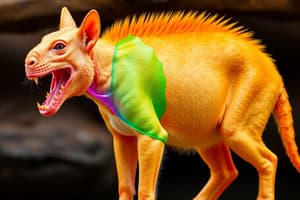Podcast
Questions and Answers
Flashcards are hidden until you start studying
Study Notes
Classifying Life's Diversity: Understanding Animals' Phyla and Kingdoms
Life on our planet is an intricate tapestry, with countless species belonging to a vast array of interconnected groups. To make sense of this complex web, biologists employ the science of taxonomy, which provides a system for organizing living organisms into a hierarchical structure. In this exploration, we'll delve into the foundational concepts of animal classification—focusing on the phyla and kingdoms—to better understand the intricacies of life's classification system.
The Phylum
Phylum is the first major grouping in the taxonomic hierarchy. It consists of a collection of related classes, orders, families, genera, and species. Each phylum represents a distinct body plan, or morphology, such as the bilateral symmetry of mammals or the radial symmetry of jellyfish. Currently, there are 35 recognized animal phyla, each described below.
- Cnidaria: Jellyfish, corals, and anemones
- Ctenophora: Comb jellies
- Platyhelminthes: Flatworms
- Annelida: Segmented worms
- Mollusca: Snails, clams, and squid
- Nematoda: Roundworms
- Rotatoria: Rotifers
- Gnathostomulida: Gnathostomulids
- Kinorhyncha: Kinorhynchs
- Loricifera: Loriciferans
- Priapula: Penis worms
- Tardigrada: Water bears
- Entoprocta: Entoprocts
- Echiura: Echiurids
- Pogonophora: Pogonophorans
- Sipuncula: Peanut worms
- Brachiopoda: Lamp shells
- Bryozoa: Moss animals
- Hemichordata: Acorn worms and prowella
- Chaetognatha: Arrow worms
- Xenacoelomorpha: Xenacoelomorphs
- Urochordata: Tunicates
- Cephalochordata: Lancelets
- Pterobranchia: Pterobranchs
- Chordata: Vertebrates and their relatives (including tunicates and lancelets)
The Kingdom Animalia
Kingdom Animalia, also known simply as Animalia, is the most inclusive category in the animal classification system. It comprises all animals, including the phyla described above. The kingdom Animalia is further divided into subcategories of increasing specificity, such as classes, orders, families, genera, and species.
The kingdom Animalia can be divided into six main subcategories:
- Annelida: Segmented worms
- Arthropoda: Arthropods
- Mollusca: Mollusks
- Nematoda: Roundworms
- Echinodermata: Sea stars, sea cucumbers, and sea urchins
- Chordata: Vertebrates and their relatives
The classification of animals is a vibrant and dynamic field, with new discoveries and revised taxonomies constantly reshaping our understanding of life's evolutionary history and interconnectedness. As we continue to explore the diverse world of living organisms, the intricate web of classification will continue to aid our quest to understand the complex tapestry of life on Earth.
Studying That Suits You
Use AI to generate personalized quizzes and flashcards to suit your learning preferences.




